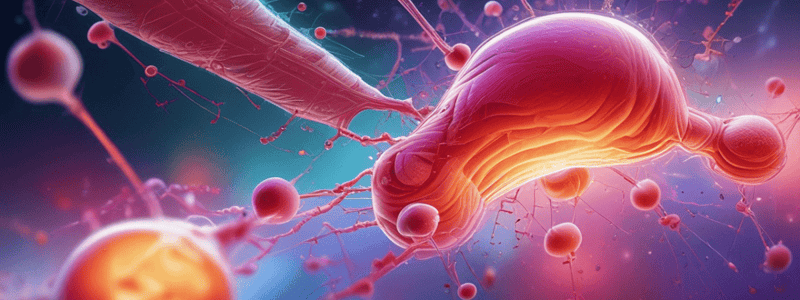Podcast
Questions and Answers
Which of the following is the MAIN purpose of therapeutic drug monitoring (TDM)?
Which of the following is the MAIN purpose of therapeutic drug monitoring (TDM)?
- To optimize treatment by maintaining drug concentrations within the therapeutic window (correct)
- To measure drug levels in body fluids on a routine basis in clinical laboratories
- To understand the factors affecting drug availability in the body
- To determine the appropriate loading dose of a drug
A patient is not responding to their current drug therapy as expected. Which of the following is the BEST next step in this situation?
A patient is not responding to their current drug therapy as expected. Which of the following is the BEST next step in this situation?
- Measure the patient's current drug concentration in the body (correct)
- Switch the patient to a different medication
- Increase the frequency of the drug administration
- Immediately double the drug dose
Which of the following factors can MOST significantly affect a drug's availability in the body?
Which of the following factors can MOST significantly affect a drug's availability in the body?
- The route of drug administration (correct)
- The time of day the drug is administered
- The patient's weight
- The patient's age
When is the OPTIMAL time to collect a sample for therapeutic drug monitoring?
When is the OPTIMAL time to collect a sample for therapeutic drug monitoring?
Which of the following is the MAIN factor that determines the duration of action of a drug?
Which of the following is the MAIN factor that determines the duration of action of a drug?
What is the main purpose of using the Levey-Jennings chart in quality control?
What is the main purpose of using the Levey-Jennings chart in quality control?
In quality control, what does the term 'shift' refer to?
In quality control, what does the term 'shift' refer to?
What is the purpose of calculating the overall lab performance using the Bias Index Score (BIS) for all analytes?
What is the purpose of calculating the overall lab performance using the Bias Index Score (BIS) for all analytes?
Why is the assessment of therapy important when a patient is clinically unstable?
Why is the assessment of therapy important when a patient is clinically unstable?
In suspected drug toxicity, what is a common reason for unexpectedly high drug levels?
In suspected drug toxicity, what is a common reason for unexpectedly high drug levels?
Which patient group is specifically mentioned as requiring close monitoring due to both over- and under-nourishment issues?
Which patient group is specifically mentioned as requiring close monitoring due to both over- and under-nourishment issues?
Which enzyme is considered the most sensitive marker for myocardial infarction?
Which enzyme is considered the most sensitive marker for myocardial infarction?
What is the primary cause of myocardial infarction?
What is the primary cause of myocardial infarction?
Which of the following liver function tests can be used as an indirect marker of atherosclerosis?
Which of the following liver function tests can be used as an indirect marker of atherosclerosis?
What is the main difference between creatine kinase (CK) and troponin in the context of myocardial infarction?
What is the main difference between creatine kinase (CK) and troponin in the context of myocardial infarction?
Which of the following liver function tests can provide information about the severity of atherosclerosis?
Which of the following liver function tests can provide information about the severity of atherosclerosis?
What is the main purpose of measuring the LDH isoenzyme pattern in the context of myocardial infarction?
What is the main purpose of measuring the LDH isoenzyme pattern in the context of myocardial infarction?
Which of the following is the primary mechanism of nephrotoxicity caused by aminoglycoside antibiotics?
Which of the following is the primary mechanism of nephrotoxicity caused by aminoglycoside antibiotics?
Which of the following statements about the ototoxicity caused by aminoglycoside antibiotics is correct?
Which of the following statements about the ototoxicity caused by aminoglycoside antibiotics is correct?
Which of the following drugs of abuse is commonly measured in urine using gas chromatography/mass spectrometry (GC/MS)?
Which of the following drugs of abuse is commonly measured in urine using gas chromatography/mass spectrometry (GC/MS)?
Which of the following statements regarding the misuse of drugs is correct?
Which of the following statements regarding the misuse of drugs is correct?
Which analytical technique is commonly used for the measurement of amphetamines in biological samples?
Which analytical technique is commonly used for the measurement of amphetamines in biological samples?
What is the key reason why therapeutic drug monitoring (TDM) is required for aminoglycoside antibiotics?
What is the key reason why therapeutic drug monitoring (TDM) is required for aminoglycoside antibiotics?
Which of the following statements about the pharmacokinetics of aminoglycoside antibiotics is INCORRECT?
Which of the following statements about the pharmacokinetics of aminoglycoside antibiotics is INCORRECT?
Which of the following drug classes is NOT mentioned in the text as requiring therapeutic drug monitoring (TDM)?
Which of the following drug classes is NOT mentioned in the text as requiring therapeutic drug monitoring (TDM)?
Why is therapeutic drug monitoring important for monitoring digoxin levels?
Why is therapeutic drug monitoring important for monitoring digoxin levels?
Therapeutic drug monitoring is not necessary for evaluating patient compliance with their medication regimen.
Therapeutic drug monitoring is not necessary for evaluating patient compliance with their medication regimen.
Therapeutic drug monitoring is primarily used to assess potential drug interactions.
Therapeutic drug monitoring is primarily used to assess potential drug interactions.
Therapeutic drug monitoring is not required for drugs with a wide therapeutic index.
Therapeutic drug monitoring is not required for drugs with a wide therapeutic index.
Therapeutic drug monitoring is not necessary for patients with organ damage, such as liver or kidney impairment.
Therapeutic drug monitoring is not necessary for patients with organ damage, such as liver or kidney impairment.
Therapeutic drug monitoring is not required for patients who are clinically unstable or have uncompensated cardiac dysfunction.
Therapeutic drug monitoring is not required for patients who are clinically unstable or have uncompensated cardiac dysfunction.
Therapeutic drug monitoring is not necessary for patients with airway disease.
Therapeutic drug monitoring is not necessary for patients with airway disease.
Drugs with a narrow therapeutic index require therapeutic drug monitoring (TDM) to avoid toxicity.
Drugs with a narrow therapeutic index require therapeutic drug monitoring (TDM) to avoid toxicity.
Aminoglycoside antibiotics are eliminated primarily through hepatic metabolism.
Aminoglycoside antibiotics are eliminated primarily through hepatic metabolism.
Therapeutic drug monitoring is not required for $\text{digoxin}$, as its plasma concentration is predictably related to its effects.
Therapeutic drug monitoring is not required for $\text{digoxin}$, as its plasma concentration is predictably related to its effects.
Aminoglycoside antibiotics primarily target anaerobic gram-positive bacteria.
Aminoglycoside antibiotics primarily target anaerobic gram-positive bacteria.
Phenytoin, an anti-epileptic drug, requires therapeutic drug monitoring due to its linear pharmacokinetics.
Phenytoin, an anti-epileptic drug, requires therapeutic drug monitoring due to its linear pharmacokinetics.
Aminoglycoside antibiotics have a long elimination half-life of approximately 8-12 hours.
Aminoglycoside antibiotics have a long elimination half-life of approximately 8-12 hours.
Aminoglycoside antibiotics are primarily distributed to the liver via active transport.
Aminoglycoside antibiotics are primarily distributed to the liver via active transport.
Ototoxicity caused by aminoglycoside antibiotics is primarily due to the generation of free radicals in the inner ear, leading to damage to sensory cells and neurons.
Ototoxicity caused by aminoglycoside antibiotics is primarily due to the generation of free radicals in the inner ear, leading to damage to sensory cells and neurons.
Amphetamines are commonly used clinically for the treatment of narcolepsy and ADHD, and their misuse can lead to an initial feeling of well-being followed by restlessness and possible psychosis.
Amphetamines are commonly used clinically for the treatment of narcolepsy and ADHD, and their misuse can lead to an initial feeling of well-being followed by restlessness and possible psychosis.
Anabolic steroids are primarily used in clinical settings to increase muscle mass and improve athletic performance.
Anabolic steroids are primarily used in clinical settings to increase muscle mass and improve athletic performance.
Cocaine is a stimulant drug that can cause a high concentration of free radicals in the body.
Cocaine is a stimulant drug that can cause a high concentration of free radicals in the body.
Creatine kinase (CK) is the most sensitive marker for diagnosing myocardial infarction.
Creatine kinase (CK) is the most sensitive marker for diagnosing myocardial infarction.
Therapeutic drug monitoring (TDM) is not required for opioid analgesics, as they do not require close monitoring.
Therapeutic drug monitoring (TDM) is not required for opioid analgesics, as they do not require close monitoring.
The main purpose of measuring the LDH isoenzyme pattern in the context of myocardial infarction is to determine the severity of atherosclerosis.
The main purpose of measuring the LDH isoenzyme pattern in the context of myocardial infarction is to determine the severity of atherosclerosis.
Aspartate aminotransferase (AST) is a specific marker for liver injury and is not elevated in myocardial infarction.
Aspartate aminotransferase (AST) is a specific marker for liver injury and is not elevated in myocardial infarction.
The primary cause of myocardial infarction is the rupture of an atherosclerotic plaque in a coronary artery, leading to thrombus formation and blood flow obstruction.
The primary cause of myocardial infarction is the rupture of an atherosclerotic plaque in a coronary artery, leading to thrombus formation and blood flow obstruction.
Therapeutic drug monitoring (TDM) is not required for CNS stimulants, as they have a wide therapeutic index and do not require close monitoring.
Therapeutic drug monitoring (TDM) is not required for CNS stimulants, as they have a wide therapeutic index and do not require close monitoring.
Apolipoprotein B-100 is the smallest single polypeptide chain known.
Apolipoprotein B-100 is the smallest single polypeptide chain known.
Chylomicrons have high density in plasma due to their nonpolar composition.
Chylomicrons have high density in plasma due to their nonpolar composition.
Insulin resistance primarily affects peripheral tissues like the liver and kidney.
Insulin resistance primarily affects peripheral tissues like the liver and kidney.
Hyperglycemia is characterized by low blood glucose levels.
Hyperglycemia is characterized by low blood glucose levels.
Ketoacidosis is commonly associated with Type 1 Diabetes.
Ketoacidosis is commonly associated with Type 1 Diabetes.
UDP-glucuronosyltransferases are involved in the breakdown of cholesterol esters.
UDP-glucuronosyltransferases are involved in the breakdown of cholesterol esters.
Study Notes
- Drugs can cause nephrotoxicity by accumulating in renal tubular cells and altering phospholipid metabolism, leading to renal vasoconstriction.
- Ototoxicity from drugs can result in mild reversible hearing loss by generating free radicals in the inner ear, damaging sensory cells and neurons.
- Drugs of abuse like amphetamines, anabolic steroids, and cannabinoids have various clinical applications and effects on the body.
- Therapeutic Drug Monitoring (TDM) involves measuring drug levels in body fluids to optimize treatment and improve patient management.
- Factors affecting drug availability for TDM include the therapeutic window, lag period, duration of action, and the necessity for drug concentration monitoring.
- Drugs like digoxin, quinidine, antibiotics, anti-epileptic drugs, psychoactive drugs, and immunosuppressive drugs require TDM due to their narrow therapeutic indices and potential toxicities.
- Aminoglycoside antibiotics, used to treat bacterial infections, have specific characteristics such as poor oral absorption, wide distribution, and nearly complete excretion through urine.
Studying That Suits You
Use AI to generate personalized quizzes and flashcards to suit your learning preferences.
Description
Learn about the definition, principles, applications, and examples of Therapeutic Drug Monitoring (TDM) in Analytical and Clinical Biochemistry. Understand how TDM helps optimize treatment by measuring drug concentrations in body fluids and its role in patient management.




